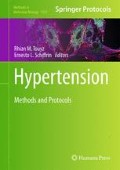Abstract
Angiotensin-converting enzyme 2 (ACE2) is a component of the renin-angiotensin system (RAS) which plays an important role in the regulation of blood pressure and volume homeostasis. Accumulating evidence shows alterations in ACE2 expression and activity in several hypertensive animal models, as well as in patients with hypertension. In order to assess the role of brain ACE2 in hypertension, a specific ACE2 assay is required. Based on a quenched fluorescent substrate, we describe an easy-to-use method for determining ACE2 activity in brain tissue and cerebrospinal fluid. The method can further be adapted for other tissues, plasma, cell extracts, and cell culture supernatants.
Access this chapter
Tax calculation will be finalised at checkout
Purchases are for personal use only
References
Xia H, Lazartigues E (2010) Angiotensin-converting enzyme 2: central regulator for cardiovascular function. Curr Hypertens Rep 12:170–175
Xu P, Sriramula S, Lazartigues E (2011) ACE2/ANG-(1-7)/Mas pathway in the brain: the axis of good. Am J Physiol Regul Integr Comp Physiol 300:R804–R817
Vickers C, Hales P, Kaushik V, Dick L, Gavin J et al (2002) Hydrolysis of biological peptides by human angiotensin-converting enzyme-related carboxypeptidase. J Biol Chem 277:14838–14843
Tipnis SR, Hooper NM, Hyde R, Karran E, Christie G et al (2000) A human homolog of angiotensin-converting enzyme. Cloning and functional expression as a captopril-insensitive carboxypeptidase. J Biol Chem 275:33238–33243
Doobay MF, Talman LS, Obr TD, Tian X, Davisson RL et al (2007) Differential expression of neuronal ACE2 in transgenic mice with overexpression of the brain renin-angiotensin system. Am J Physiol Regul Integr Comp Physiol 292:R373–R381
Warner FJ, Lew RA, Smith AI, Lambert DW, Hooper NM et al (2005) Angiotensin-converting enzyme 2 (ACE2), but not ACE, is preferentially localized to the apical surface of polarized kidney cells. J Biol Chem 280:39353–39362
Lambert DW, Yarski M, Warner FJ, Thornhill P, Parkin ET et al (2005) Tumor necrosis factor-alpha convertase (ADAM17) mediates regulated ectodomain shedding of the severe-acute respiratory syndrome-coronavirus (SARS-CoV) receptor, angiotensin-converting enzyme-2 (ACE2). J Biol Chem 280:30113–30119
Epelman S, Tang WH, Chen SY, Van Lente F, Francis GS et al (2008) Detection of soluble angiotensin-converting enzyme 2 in heart failure: insights into the endogenous counter-regulatory pathway of the renin-angiotensin-aldosterone system. J Am Coll Cardiol 52:750–754
Kawajiri M, Mogi M, Higaki N, Matsuoka T, Ohyagi Y et al (2009) Angiotensin-converting enzyme (ACE) and ACE2 levels in the cerebrospinal fluid of patients with multiple sclerosis. Mult Scler 15:262–265
Pedersen KB, Sriramula S, Chhabra KH, Xia H, Lazartigues E (2011) Species-specific inhibitor sensitivity of angiotensin-converting enzyme 2 (ACE2) and its implication for ACE2 activity assays. Am J Physiol Regul Integr Comp Physiol 301:R1293–R1299
Sriramula S, Cardinale JP, Lazartigues E, Francis J (2011) ACE2 overexpression in the paraventricular nucleus attenuates angiotensin II-induced hypertension. Cardiovasc Res 92:401–408
Wysocki J, Ye M, Soler MJ, Gurley SB, Xiao HD et al (2006) ACE and ACE2 activity in diabetic mice. Diabetes 55:2132–2139
Ferrario CM, Jessup J, Chappell MC, Averill DB, Brosnihan KB et al (2005) Effect of angiotensin-converting enzyme inhibition and angiotensin II receptor blockers on cardiac angiotensin-converting enzyme 2. Circulation 111:2605–2610
Poglitsch M, Domenig O, Schwager C, Stranner S, Peball B et al (2012) Recombinant expression and characterization of human and murine ACE2: species-specific activation of the alternative renin-angiotensin-system. Int J Hypertens 2012:428950
Enari M, Talanian RV, Wong WW, Nagata S (1996) Sequential activation of ICE-like and CPP32-like proteases during Fas-mediated apoptosis. Nature 380:723–726
Douglas GC, O'Bryan MK, Hedger MP, Lee DK, Yarski MA et al (2004) The novel angiotensin-converting enzyme (ACE) homolog, ACE2, is selectively expressed by adult Leydig cells of the testis. Endocrinology 145:4703–4711
Huang L, Sexton DJ, Skogerson K, Devlin M, Smith R et al (2003) Novel peptide inhibitors of angiotensin-converting enzyme 2. J Biol Chem 278:15532–15540
Feng Y, Xia H, Cai Y, Halabi CM, Becker LK et al (2010) Brain-selective overexpression of human Angiotensin-converting enzyme type 2 attenuates neurogenic hypertension. Circ Res 106:373–382
Zapata A, Chefer VI, Shippenberg TS (2009) Microdialysis in rodents. Curr Protoc Neurosci Chapter 7:Unit 7.2
Huentelman MJ, Zubcevic J, Katovich MJ, Raizada MK (2004) Cloning and characterization of a secreted form of angiotensin-converting enzyme 2. Regul Pept 122:61–67
Acknowledgments
This work was supported by research grants from the American Heart Association (Established Investigator Award: 12EIA8030004) and National Institutes of Health, National Institute of General Medical Sciences (8 P20 GM103514-10), National Institute of Diabetes and Digestive and Kidney Diseases (DK084466), and National Heart, Lung, and Blood Institute (HL093178) to Dr. Eric Lazartigues.
Author information
Authors and Affiliations
Corresponding author
Editor information
Editors and Affiliations
Rights and permissions
Copyright information
© 2017 Springer Science+Business Media LLC
About this protocol
Cite this protocol
Sriramula, S., Pedersen, K.B., Xia, H., Lazartigues, E. (2017). Determining the Enzymatic Activity of Angiotensin-Converting Enzyme 2 (ACE2) in Brain Tissue and Cerebrospinal Fluid Using a Quenched Fluorescent Substrate. In: Touyz, R., Schiffrin, E. (eds) Hypertension. Methods in Molecular Biology, vol 1527. Humana Press, New York, NY. https://doi.org/10.1007/978-1-4939-6625-7_9
Download citation
DOI: https://doi.org/10.1007/978-1-4939-6625-7_9
Published:
Publisher Name: Humana Press, New York, NY
Print ISBN: 978-1-4939-6623-3
Online ISBN: 978-1-4939-6625-7
eBook Packages: Springer Protocols

